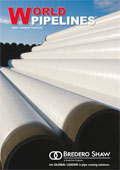Editorial comment
Last week we learned that Sinopec, China’s biggest refiner, is to invest in Enbridge’s proposed Cdn$ 5 billion Northern Gateway pipeline project, as part of a group of funding partners contributing more than Cdn$ 100 million between them. According to Enbridge sources, a group of Canadian producers and Southeast Asian refiners is matching Enbridge costs in order to push the pipeline through the regulatory approvals process. The 36 in. Northern Gateway pipeline is designed to transport as much as 525 000 bpd of crude from the Canadian oilsands to the west coast of Canada for shipment to Asia and the USA. A twin pipeline will carry condensate in the opposite direction, which will be used to thin petroleum products for pipeline transport.
Register for free »
Get started now for absolutely FREE, no credit card required.
Pat Daniel, President and CEO of Enbridge has said that the ability to reach energy-hungry Asian markets would add some Cdn$ 2 - 3 to the value of each barrel of oilsands bitumen, bolstering the bottom lines of Alberta producers. It certainly gives the producers a little more leverage: to be able to decide to ship to the Pacific coast and then off to Asia will be an extra bargaining tool for negotiations with US refiners. The US is currently the only export market for Canadian crude oil, and Canada is the US’s largest single supplier.
There are obstacles to the pipeline, notably opposition from First Nations, which is opposed to the additional tanker traffic off the west coast, and Greenpeace demonstrated at the most recent investor conference in Whistler. The growth of the oilsands industry is a concern for many, who criticise it for its greenhouse gas emissions and its heavy use of water. However, despite opposition, this injection of financial support will go some way to moving the pipeline forward. It is the latest in a string of Asian investments in Canada’s oilsands, which run to billions and billions of dollars.
The news of the Sinopec investment follows in the wake of several other big China stories in the press so far this year, including President Obama’s summit with Chinese President Hu Jintao, and the announcement that China’s economy is now the second largest in the world after the USA. Talk abounds about the notion of China joining the US as a fellow ‘superpower’; that is, holding an equally dominant position on the international stage. Both Washington and Beijing are very much concerned about energy security, and if we’re talking about China ramping up its connections with Canada, and supporting a new pipeline to the west coast, then here’s a nice little triangle of supply and demand, where previously Alberta oil could only be piped to the US.
A superpower is often defined in terms of its superior military, economic, political and cultural influence. China overtook Japan to gain its title as the second largest economy in the world and, like Japan before it, has grown to be a powerful driver of the global economy.
In an article in the The Globe and Mail (Canada), Campbell Clark writes about the potential formation of “a new world order dominated by a US-China ‘G2’”.1
Whether or not this match-not-quite-made-in-heaven will materialise, the Sino-American relationship will certainly be on the minds and in the conversations of those who are attending the World Economic Forum in Davos, which is currently taking place in Switzerland. An elite international crowd gathers together to talk and talk and talk and meanwhile, Asia buys up interests worldwide and continues on its upwards trajectory.
1.‘Will Canada play energy card in a U.S.-China world?’, Campbell Clark, The Globe and Mail, Wednesday 19th January 2011.


